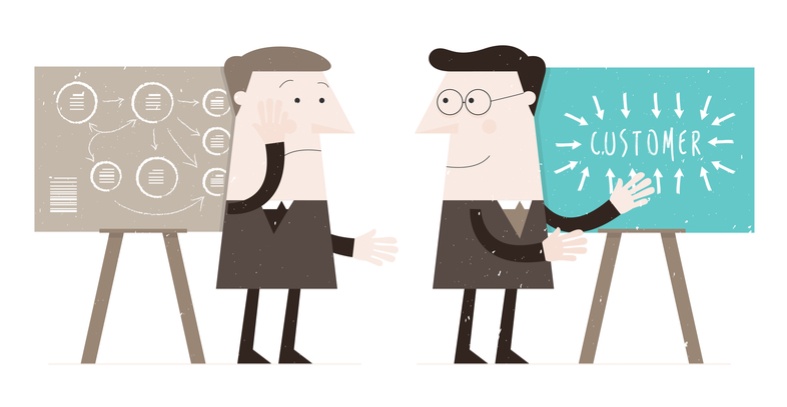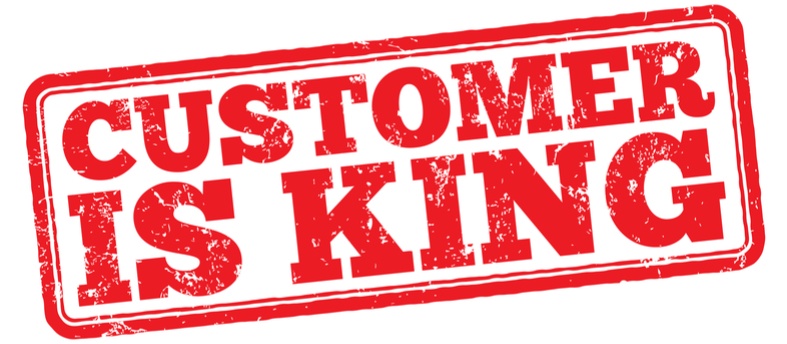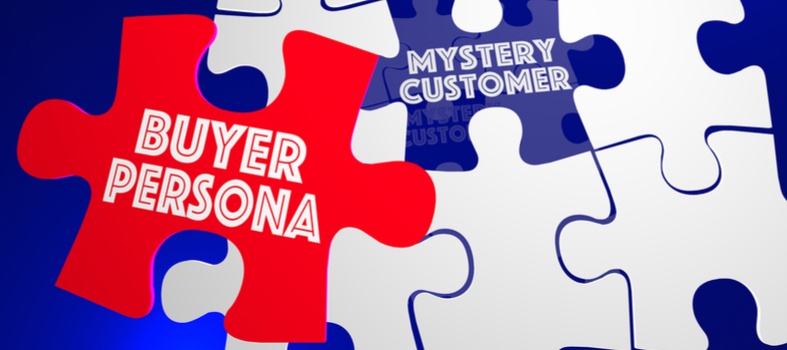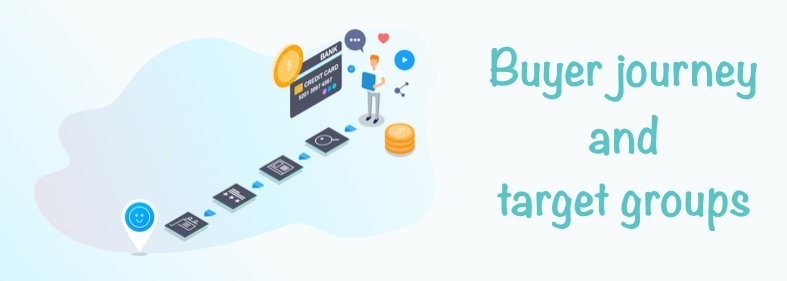How to get your customer-centric online marketing strategy right?
The customer is king, and the customer is always right. Two tired, over-used phrases that bring us back to the flashy world of physical sales with its hard-sell tactics and thin veneer of customer care. If you need to say either of these phrases out loud, something’s not right. Yet we all know that customers should be central – after all, they are the root of your turnover.
Most business owners know that a positive customer experience should be of priority within each department, from customer services to advertising, and from web design to product research. Actually putting this knowledge into action is a completely different kettle of fish. In practice, customer-centric business management is not the foundation of every business. Especially when it comes to marketing strategies.
It makes complete sense that the client comes first in any customer services department. In marketing, the customer often comes second. Marketing is for the good of the business, right? So marketing is product-centric, or sales-centric, with a little something for the customer added on. This is, simply put, the wrong perspective.
Customer as King
Customers don’t expect you to pay a financial tribute on a regular basis. Except for an annoying few who use baiting and complaining as their own personal marketing strategy (often on social media), the also don’t expect your company to do what they tell you. Your customer is not a tyrant or dictator you should grovel to. Crowning your customers with respect and showing your appreciation is often enough.
Putting the customer first means that you know them, have identified their problems, and offer them an effective solution. So do we offer our customers a product, or do we offer them a solution? There’s an easy answer. Do you add Google maps to your phone because it looks good? Or do you take the time to install it because you are going on holiday and need a reliable navigation system which shows you where the local attractions are? You install a solution that coincidentally is also a product. The solution is key.
Half of your work is already done
As a business owner, you must be able to identify your client’s problems and respond to them. This means you become valuable to your customers. The time of cold-calling is over. It is no longer easy to get a reaction from desensitized social media users who simply ignore advertising banter unless they really are looking for a way to lose weight without needing to exercise, or the cheapest roof insulation. If not, these messages – no matter how cleverly they have been done – hardly register. Today’s customers are looking for relevant information when already in the purchasing phase. You very rarely need to do the extra footwork to attract them into this phase – they are already there.
The customer journey
The customer journey runs from the moment he or she recognises a problem right up to where he or she makes a purchase. There are several steps in between that are important to the customer, and therefore important to your business. By guiding the customer in this journey and assisting so that the customer makes a well-considered choice (your product) is what today’s customer expects. A customer does not suddenly decide to go to the app store to install Google maps on a whim. He or she first – sometimes gradually, sometimes immediately – realises that there is a problem and that this specific app is the solution. Why this particular app? It provides exactly what the customer needs, is a brand the customer recognises, is priced correctly (in this case, free), has good reviews and is already used by millions. Also, once the problem has been solved and the holiday is over the customer has a choice. Uninstall the app, or keep it for further reference. This is a post-journey aspect that businesses should also not ignore, often known to the purchasing community as ‘fine print’.
Knowing who your customer target is and being able to define it is extremely relevant to your marketing strategy. This journey consists of 3 phases:
1. Awareness of a problem which requires a solution
2. Researching which product or service offers the best solution
3. Deciding to proceed with the purchase of the best product or service that solves the problem
The question is, how does a marketing department achieve this effect?
Customer-centric marketing 101
Let’s assume that your business already provides great customer service. This is a basic and essential element of good entrepreneurship. However, in order to make the customer central to your online marketing strategy, you need to take four specific steps.
Check, check, then check again
A premium online marketing strategy starts and ends with testing and analytics – data-driven marketing. Data collected through different marketing channels is invaluable, especially when it comes to your customers. When your goal is to crown your customers King, you first need to get to know them, and there is no other way to do this over the Internet than through the gathering of relevant data. Your first step is to provide insight into collected data that concerns client interests, search behaviour, demographic and geographical information, and any other relevant matters concerning purchasing and journey behaviours.
Buyer persona
Once you have insight into this data (by linking all data from your Google Analytics account to Google Data Studio, for example) you can start to create one or more buyer personas. A buyer persona is your profile of your particular customer type based on practical experience (customer interviews and customer service department information) and hard data gathered from your marketing channels.
The buyer persona gives you a much better insight into who your customer actually is, what concerns them, where his or her interests lie, and what drives them to make a purchase. This profile is essential for any customer-centric marketing strategy. The more detailed the buyer persona, the better your understanding of your customer. The better you understand them, the easier it is to put them at the centre of your entrepreneurial universe.
Buyer journey and target groups
The three steps of the customer journey as previously described can be integrated into an online marketing strategy with a little thought and preparation. Each buyer persona – or each of your company’s target groups – has a personal, very specific type of journey. It is therefore impossible to make a discernible difference to this journey unless you have identified your customer and learned more about what it is that makes them tick. Once this has been done, it is time to link the three phases of the customer journey per group, using them to create separate marketing campaigns.
1. Customers who have not yet realised that they have a problem
2. Customers who realise there is a problem, but have not yet found its solution
3. Customers who already know what the problem is and which solution(s) are available
4. Customers who know what their problem is and are aware of the product or service that offers the best solution
This is how a business creates a customer-centric marketing strategy. Through your buyer persona profile a customer group receives relevant content, appropriate to every step of the buyer journey.
Relevant content
Successful online marketing strategy ultimately depends on the content that is offered to the customer. Content must be relevant to the particular phase the customer is in. If content is not relevant enough to offer a solution to a customer’s problem, that person will look for another party who does. If the content treats the customer like a simpleton, giving extremely basic information when the customer has already carried out the appropriate research and is in the phase of best product purchase, you may even offend them. If someone still hasn’t realised they have a problem, there is no point in offering a demo. For the customer sifting through the various solutions, a Top Tips list will have much less impact than product comparison. With a buyer persona on hand, there is no excuse for your marketing department to publish irrelevant content.
What is crucial here is that this content is only ever offered from the perspective of the customer and not from the perspective of your bookkeeper. Online customers are too savvy for the hard sell, and already have a lot of choice. Also, if your information is very relevant the customer is much more prepared to do something in return, such as fill in their contact details.
Relevant content has an additional role. It creates a trusting relationship between your online presence and your target group. Once this relationship has been formed, customers will rely on your website for further assistance in the research and purchasing phases. If turnover is your marketing department’s only concern, a trusting relationship is difficult to build. Investment into a detailed, non-plagiarised blog with carefully researched information to describe the problems your target customers face, or the creation of a comparison website based upon real, not purchased, reviews and your in-house expert’s own opinion is never wasted.
Through the data collected in step one, the buyer persona created in step two, and your awareness of the customer journey in step three, it is now possible to create extremely relevant content for each phase of the purchase process of your ideal customer.
Customer-centric marketing – a real no-brainer
Every marketing department needs to meet and discuss the same questions at regular intervals, looking at changes in trends and the evolution of data as and when it occurs. Each meeting should ask the following questions time and time again in respect to each product or service on offer:
1. Who is our target customer?
2. What problem does this customer face?
3. How far is the customer from finding a solution?
4. How do we offer the solution?
5. How do we get the customer to pick our solution?
By answering these questions and making them the foundation on which your online marketing strategy is constructed, your customers are guaranteed the starring role. This approach changes sales-first strategies to customer-first, from push marketing to pull. Your targets will take notice. When your marketing method brings them to view you as the best point of contact for their problems because you always know the correct answer, you will have achieved something no sales-first marketing campaign can pull off. Becoming an information-point leads to conversation and discussion – customer communication at its best. In fact, when you put your customer first, chances are your customer will put you first, too.


 1300 353 700
1300 353 700 info@magiknewmedia.com.au
info@magiknewmedia.com.au



















